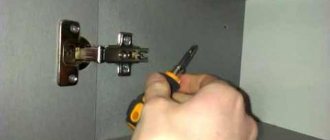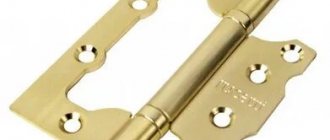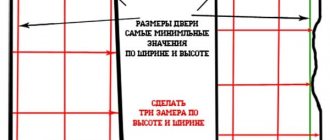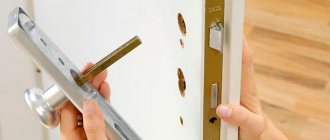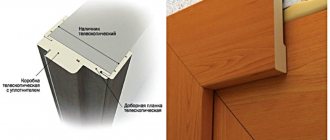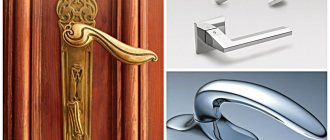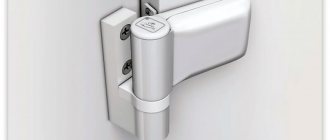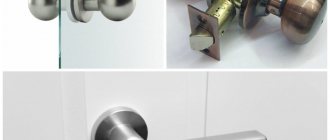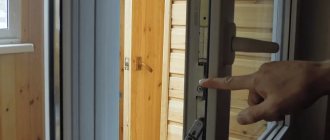Hinges, Miscellaneous
Swing doors will not perform their functions if they do not have hinges. These simple details ensure the operation of the valves. Today, many hinge designs are known. Hidden hinges for interior doors are considered attractive. They are installed in such a way as to be completely hidden from human eyes. But at the same time, the canvas can open 180 degrees.
How to embed and adjust hidden hinges
The process of installing hidden hinges on metal and wooden doors is almost the same: you need to cut a recess of the required size, insert the mechanism into it and secure it.
Depending on the material of the canvas and frame, special tools and ability to handle them will be required.
Into a wooden canvas
To install hidden hinges in a wooden panel you will need:
- milling machine;
- electric drill with feather drills;
- pencil;
- chisel;
- hammer;
- screwdriver
Since the hole will be made at the end of the leaf, the door must be installed vertically and securely fixed to make it easier to work with. To do this, use clamps or special wooden bases with recesses of a given thickness.
In order for the notches to exactly match the size of the loop, you need to make 2 templates from plywood or several boards. The first template will be designed to cut out the outer part of the loop. The second is for the internal, shorter and deeper recess. The templates are placed at a distance of 20-25 cm from the edge of the end and secured with clamps.
First, the top layer of wood is removed with a milling machine, forming a recess corresponding to the front part of the hinge. Then the templates are changed and the main recess is cut out. Since the machine does not provide the required cutting depth, first the dimensions and shape are outlined with a milling cutter, and then they are armed with a drill with a feather drill and alternately create a recess. You need to level the inner walls with a chisel and hammer.
Now you need to transfer the markings to the door frame striker to determine exactly where you need to make a recess for the second part of the canopy. To do this, combine 2 structural elements, marking the boundaries using the same templates, and excavate the array.
After the formation of the recesses is completed, holes are drilled for fasteners, first the loop is screwed to the canvas, then the part intended for the box is installed and secured.
Hidden canopies for steel doors
Most often, metal doors are sold with hinges, since it is difficult to install a turning mechanism on a finished door at home. If you have to deal with an assembled box, they give preference to simple external canopies.
First, at the end of the frame, which will connect to the door leaf, a slot is made that is larger than half the hinge. Then the lower element is inserted into the hole and welded.
The upper part of the mechanism is first attached to the arc-shaped extension, and then directly to the door. In the end you just need to connect both parts. After installing such a rotating mechanism, it will not be possible to adjust it. It is necessary to ensure the correct arrangement of the elements relative to each other.
If you choose the right turning mechanism and carry out all the work efficiently, such a device will be able to withstand even the heaviest metal doors.
Construction of houses
Hinges are accessories that just a few years ago were an unremarkable unit of one option. Now the situation has changed and this fittings may be different. Hinges are necessary to open and close doorways. There are several options for mounting door hardware, the methods directly depend on the type of door. To carry out this work, you need some skills, a suitable tool and an understanding of a certain sequence of actions. Most often, hidden loops are chosen, since they are almost invisible and thanks to this everything looks more attractive. The insertion of closed loops is available to any craftsman.
Table of contents:
Hinge options for interior doors
There are currently five options for door awnings. Each option has its own specificity and strengths. You can find and purchase the following types of canopies:
- straight or card - simple classic, with special side plates;
- corner - similar to the first, classic canopy with a slight difference in the shape of the plates, most often installed on pendulum structures;
- “invisible” - special mechanisms that are recessed into the door leaf, most often used on expensive doorways;
- eversible - there are no plates, but only pins on a special eversible axis;
- Italian - equipped with a special hinge, installed on European doors.
All interior hanging structures are divided into universal ones and those that have a specific direction: right-handed and left-handed.
As for the loop options, they are:
DIY hidden door hinges
Most often, the invisible version of the loops is a priority, as it allows you to make the object aesthetically attractive. Installation of this fittings is a little more complicated than overhead fittings and also requires more time, but if you wish and have some skill, you can install the hinges quickly and correctly with your own hands.
The advantages of this option are as follows:
- Reliability and safety - thieves will not be able to enter the premises due to the fact that they cut off the hinges, as happens with overhead options; hidden hinges are hidden from outsiders.
- High strength - the product can easily withstand the weight of the structure itself, made of metal or wood material.
- Practicality - products can last for decades with proper care.
- Visual appeal - when the doors are closed, the hinge is not visible, this allows you to maintain the aesthetics of the appearance.
- Wide variety - you can choose canopies that can withstand heavy loads or small designs for closet doors.
The disadvantage of this method is the fact that installation is not easy and requires some effort. In addition, there are a number of weaknesses of this product:
- A hidden canopy is expensive compared to other options. But even among the category of hidden interior structures, you can find those that stand higher or lower. It should be understood that the quality of the hinge directly affects the price of the product.
- Unfortunately, there are a large number of fakes on the market; as a result, you can purchase a low-quality product and lose money
- A noticeable disadvantage is the fact that not every canopy can be disassembled if necessary.
- Due to the large recessing depth, it is not always possible to install this type of canopy.
Installing hidden hinges on doors
If you do not delve into the specifics of installing the door structure, then installing the hinges of the hidden version is simple and straightforward: you need to cut a niche and insert the mechanism, then securely fasten it and start using it. But in reality, everything is a little more complicated.
Installing hidden hinges yourself is not entirely easy. It is necessary to stock up on the tools needed to carry out the work. In addition, there is an instruction that describes all the stages; following the recommendations of specialists allows you to install the mechanism efficiently and quickly. The following tools and items are required for installation:
- "invisible loops";
- fastening elements for installation;
- a simple pencil;
- yardstick;
- sharp knife;
- chisel;
- screwdriver;
- screwdriver;
- hammer.
First of all, you need to make a hidden basting. It is important to think about which direction the door will open and at what level the hidden door hinges will be located. This is not at all blindly following the requirements for show; in fact, this will affect the ease of use, durability of the canvas and consumables. To slow down the swinging of doors, experts advise installing special stoppers. In this case, the door will not hit adjacent furniture or the wall.
The number of hinges depends on the characteristics of the door: material, weight, purpose. A classic door requires the installation of two hinges, this is enough. A door made of heavy wood has a different weight, so a couple of hinges will not be enough; three elements need to be installed. Two are installed near the floor and top of the doorway. The third loop is located in the center of the side panel. All attachment points are marked with a pencil. It is necessary to calculate the depth of the excavation in advance.
How to install concealed awnings
As already mentioned, depending on the weight and size of the door, the number of hidden hinges is planned. The markup has specific stages, and they can be displayed in the following order:
- at a distance of twenty to twenty-five centimeters from the top and bottom, a mark is placed for future loops; for convenience, you need to mark with a simple pencil;
- to the future location of the canopies, it is necessary to attach loops and outline their contours;
- when installing the third loop, it is placed strictly in the center, at an equal distance between the first and second;
- two contours are immediately marked, internal for the canopy and external for the lining.
Marking a door, namely a door frame, is considered a difficult task. Like any other process, door marking has its own order and looks like this:
- the accuracy of the door leaf is measured using a building level and secured with wooden wedges;
- now you need to mark the places where the loops will be inserted;
- The loops are outlined with a pencil to indicate their attachment location.
To avoid mistakes, you need to carefully carry out the insertion process. Holes must be made after several checks of the correctness of the future location of the hinged hinges of the hidden version.
How to decide on the choice of invisible loops
The hidden mechanism is a kind of invisible mechanism, equipped with a hinge, equipped with two elements connected by a screw. To make the right choice when purchasing hidden mechanisms, you should listen to the recommendations of experts:
- before purchasing a mechanism, you should study their features; if they are not universal, then you need to decide on the sides of the attachment - right or left;
- if the hinges are inexpensive, then most likely the manufacturer saved on the control mechanism;
- When installing heavy doors, you should not prioritize the issue of savings;
- when installing a door in a new building, it is necessary to purchase a copy with adjustment so that when the house shrinks, it is possible to correct the misalignment of the door, which will happen in any case;
- when installing awnings with adjusting screws, there will be no problems with large objects drifting in - the swing angle of the sash can reach 180 degrees;
- It is necessary to select hinges based on the characteristics of the door.
Door frame: how to install hidden hinges correctly
The first step to install the mechanism is milling. This is the creation of shallow recesses for recessing hinge elements. It is possible to make such connectors yourself using a hammer and chisel. The main requirement for the notch is accuracy and correct size. The depth of the notch depends on the thickness of the loop, and if a shallow one can be widened, it will be very difficult to correct an excessively deep one.
Using a drill, make a recess along the contour outlined with a simple pencil. There is no need to rush; the result depends on the measured actions. It is necessary to make recesses in the sash and in the frame. This work takes no more than forty minutes. The hinges are installed in the cleaned recesses. This involves the following actions:
- the canopy is immersed in a specially made hole, you need to ensure that the part fits tightly and takes its place;
- Recesses are made for the screws with a special tool - a screwdriver;
- You need to insert loops into the resulting recesses and tighten them, you need to make sure that the loop does not skew.
If necessary, it is important to adjust the “invisible” hinges. In this case, you can check the functioning of the door and make sure that the “invisible” hinges are located correctly.
Hidden hinges for doors with your own hands, adjustment
The adjustment features depend on the type and version of the loop. And although there is a wide range of hidden-mount hinges on the market, they all have identical adjustment options and design. To adjust the hinges, you must follow the following steps:
- the cover is removed from the loop, this allows you to expose the adjustment mechanism;
- to change the vertical skew of the door, you should turn the bolt; this manipulation can be done using a special hex key;
- Under the mechanism panel there is a screw with which the surface of the blade is adjusted.
Expensive and complex structures have a complex adjustment mechanism in three directions at once, and this makes it possible to create ideal conditions for operation and quality of service.
It is necessary to avoid the situation when hinges are purchased immediately before installing the product. Such purchases can be made in a hurry and without taking into account many features, which will negatively affect the durability of the door. It is recommended to purchase hinges in parallel with the purchase of the door, in order to take into account its dimensions and weight, and select the color of the hinges. And although they are called hidden and are partially recessed, they are visible when the doors are open, so it is advisable to select a shade.
Also, you should not purchase a mechanism of unknown origin or go for cheapness: hinges ensure reliable opening and closing of the door.
You can make installation easier and faster using a special template. This will help avoid mistakes when basting.
How to hide door hinges, requirements for the mechanism
There are certain requirements for fittings. The main thing is that they must withstand mechanical loads. Since the door material can be different, awnings are divided into three main categories:
- for doors up to sixty kilograms of weight;
- for a one hundred and twenty kilogram door;
- for massive structures weighing up to two hundred and fifty kilograms.
If the door has even more weight, individual structures for fastening are made. There are a number of requirements for hinges:
- they must be durable, reliable, and easy to install;
- the form must be made in such a way that the fastening is as reliable as possible;
- it must be taken into account that during its service life the door can open half a million times, so the material must be appropriate;
- priority is given to the use of hinges made of aluminum, hard plastic or metal - depending on each specific situation;
- parts must be coated with anti-corrosion agents.
If you still have questions about how to make a choice and install hidden hinges with your own hands, watch the video. There you will find answers to all questions. It is possible to install hidden hinges on your own if you follow the recommendations and prepare the necessary tools. The use of such mechanisms will allow you to enjoy the quality and aesthetics of the product.
A few words about adjustment
There are a number of models that provide the ability to adjust the position of the door leaf in 3 directions.
Adjustment of hidden hinges of interior doors is carried out using a hex key. The location of the adjusting screws for adjusting the position of the leaf is provided in that part of the mechanism that cuts into the door frame:
- adjustment in the horizontal plane is carried out by a screw located on the surface of the element;
- vertical adjustment is carried out with a screw located vertically;
- To ensure the necessary pressure, the adjustment mechanism is an eccentric.
If we are talking about the position of the blade relative to the box, the available stroke is 1 mm up-down, left-right and is done by turning the screw on both hinges at the same time. The depth of the clamp can be changed by tightening 2 eccentrics with a hexagon.
When opening spontaneously
The reason for spontaneous opening/closing of the door may be improper installation of the frame, namely, tilted forward or backward.
To solve the problem, you will need to adjust its position. When opening or closing the door yourself, you should align the frame vertically. In this case, the beam on which the fittings are installed is subject to adjustment. You should also check the hinges for their alignment.
If the box is installed correctly and the fittings are located on the same axis, it is recommended to replace the hinges with new ones. The reason may lie in their wear and tear.
What it is?
Hidden hinges (also called secret hinges) are installed in special holes that are made inside the door frame and leaf. They provide easy, smooth movement and are not visible when the sash is closed.
They are also unregulated and adjustable. Adjustment allows you to even out distortions in the door leaf, various gaps that form during long-term use or due to improper installation. You can install in:
- wooden;
- aluminum;
- or steel structures.
Advantages
Metal hidden hinges have a number of advantages compared to other types of hinges.
- Reliable to use. Hidden hinges, thanks to their special design, are practically unbreakable.
- They are not visible. Interior doors with hidden hinges are most often installed where the design of the room requires it. Installed at the entrance, they increase safety, since it is very difficult to get to them and cut them off, like mounted ones.
- Adjustment in three planes is possible after completion of installation and hanging of the door leaf.
Advantages and disadvantages of products
Before purchasing accessories, you need to consider in detail its pros and cons. Advantages:
- Safety . The hinges that are hidden inside the door structure cannot be knocked out or cut down. Of course, this factor is more useful for input, but in other cases it is also an advantage.
- Stealth . An important feature for interior doors, since ordinary hinges do not always fit into the interior of the apartment.
- Range . The buyer is presented with various accessories for both light canopies and solid massive canvases.
- Large door opening angle . The vast majority of models allow you to open it so that it becomes parallel to the adjacent wall and does not interfere with the passage.
- Durability . They are made from steel or alloys that are highly wear-resistant. Recessing the mechanism inside the box and canvas also provides additional reliability.
Of course, the products have disadvantages:
- Difficult installation . To install, you need to cut grooves of the desired shape and size inside the box and canvas. Not every craftsman has a tool (mill).
- Price . High-quality components are expensive (from 1800 rubles per piece). You can find cheaper products on the market that cost several times less, but their quality will be appropriate. Cheap parts cannot be adjusted.
- Difficult to dismantle. If you need to remove a door, sometimes you have to completely disassemble and remove the hinges.
- Increased volume . In the canvas itself there is usually enough space for fittings, but in a thin box the depth is sometimes not enough.
Below are photos of the products:
Aluminum door hinges
The popularity of aluminum products is ensured by their beautiful aesthetic appearance, durability of the material, and low weight. Therefore, increased demands are placed on door hinges made from it, especially considering that, with rare exceptions, their adjustment is impossible. Of course, hot-pressed aluminum, which is used to make hinges, is a durable material with high wear resistance.
It is not recommended to install products made from low quality materials on these doors.
Even a slight impact of the door on the frame or slope can cause a crack or breakage. That’s why non-adjustable hinges are installed on such doors: if they are of high quality, they last a long time and reliably, but if they are of poor quality, they cannot be repaired, much less adjusted.
Installation diagram
The technology for installing them is simple: you need to cut niches, insert parts into them, and secure them. In reality, things are a little more complicated.
You must first prepare the necessary tools:
- measuring instruments (tape measure, ruler, level);
- pencil;
- hand router (you can use an electric drill with a milling attachment);
- screwdriver;
- chisel;
- hammer.
The process itself looks like this:
- First they mark the door . To do this, measure 20–25 cm from the top and bottom edges, mark the place for the loop, and trace its contours. You need to make two contours: for the loop itself and for the decorative overlay. If you intend to install a third, then it must be placed exactly in the middle between the two outer parts.
- Then mark the door frame . The door is inserted into place and its position is adjusted using pegs. Find the designated places on the canvas, fix their position on the box. The sash is removed, and contours are also drawn in the marked places.
- Now we move on to inserting parts. It is necessary to make a hole for the lining, the depth of which is equal to the thickness of the part. They shape it with a chisel and a hammer, then take a drill with a milling attachment and make the final niche for the fittings.
- After creating the recesses on the sash and frame, the elements begin to be fixed . They are separated into two halves, inserted into the prepared holes, and screwed with a screwdriver. This must be done evenly to avoid distortion.
Proceed to hanging the doors and adjusting the hinge mechanism (if necessary). After all work is completed, the fittings are covered with a decorative overlay.
Butterflies
“Butterfly” is one of the varieties of overhead one-piece loops.
It is suitable for doors with low weight. This model got its name due to the similarity of its shape to the wings of a butterfly. Professionals call such a loop a card loop. The butterfly can be adjusted in different planes:
- Horizontally. The work is done using the adjusting screw. You should loosen it a little and level the door. It is recommended to alternately loosen and tighten the screw, checking the result each time.
- Back and forth. You need to slightly loosen the fixing screw on the overhead hinge. Then, by tightening and loosening it, you should align the door.
- Vertically. Adjustment is made using the upper and lower screws on the installation pad.
To perform the work efficiently and achieve the desired result, actions must be precise and accurate.
Adjustment
After installing the adjustable hinges, you need to adjust them with a hexagon.
High-quality fittings can be adjusted in three directions:
- Horizontally. The adjustment aligns the sash on both sides relative to the frame by 1 mm. You need to turn the adjusting screw, which is located on the upper right side of the hinge.
- Vertical. You can get rid of the gaps between the door itself, the floor and the top of the frame. The magnitude of the changes will be 1.5-2 mm. To adjust, turn the screw that connects the two levers of the hinge assembly.
- By pressure . This action evenly presses the canvas against the box (approximately 1 mm). To adjust the pressure, rotate the eccentric located on the left.
Adjustment can be made if the decorative trims are removed.
How to set up
During adjustment, the same gap is established around the perimeter of the door. Installed hidden hinges allow you to customize the door without dismantling it.
Hidden loop device diagram
Adjustment work is carried out in several planes using special hexagons.
- Height adjustment. A gap is set at the bottom of the door leaf and the same size is maintained at the top of the door.
- Horizontal adjustment. The door is aligned with the frame, certain gaps are established.
- Pressure adjustment. To do this, turn the adjusting eccentric. As a result, the leaf is pressed tightly against the frame anywhere around the door perimeter.
The adjustment size ranges from 1 to 5 millimeters. It all depends on the manufacturer.
After completing the adjustment work, decorative plates are installed. Mounting bolts and adjustment holes will be hidden under them.
Installation of a door structure with hidden fittings
The installation of doors is carried out after the installation of hinge mechanisms. Procedure:
- Install the sash into the frame opening.
- Secure it using a building level and wooden pegs so that it is strictly parallel to the walls and perpendicular to the floor. The door should not be in the closed position, but should be slightly open so that you have access to the hinge assembly.
- Make sure that its halves are located opposite each other, fix the door.
- Connect with a mounting screw.
After connecting all the elements, you can remove the pegs and make sure the installation is correct. If necessary, complete the adjustment and complete the installation by attaching the linings.
Hidden hinges are wonderful fittings that are beneficial for installing interior doors. But their installation is complicated by the fact that it is necessary to cut out hidden holes. The process is not very labor intensive, so following the steps you will get an inconspicuous fastening.
How to adjust locks
The initial stage is disassembling the device. It will depend on the design features whether it will be necessary to dismantle the linings, locking mechanisms and remove the handles. The main method of adjustment and correction will be determined by the symptoms of malfunctions. If the door lock is jammed, lubricate the latches with machine oil or grease. When lubricating, rotate them so that the liquid spreads throughout all the insides of the mechanism. If the lock has a short hidden tongue, then there are adjustments for the extension of the tongue, which is built inside the handle. You can adjust the reach by rotating a screwdriver in a special groove. This applies to both the locking mechanism tongue and the handle tongue.
Design features of hidden hinges
The main feature of such door hinges is their invisibility after installation. To do this, the component elements of the product are cut into the door frame and leaf.
Hidden door hinges must provide during operation of the door unit:
- Reliable connection of the canvas with the box, without the risk of disconnection;
- Free opening/closing of the door leaf;
- Maintaining its original technical characteristics throughout the entire warranty period;
- Fixation of intermediate and extreme positions of the canvas;
- Hidden-type door hinges are also required to withstand the weight of the door, possible impact loads and provide the set opening angle - 90, 120, 180 degrees.
Functions and Features
Door hinges perform important functions. With their help, the canvas is attached to the box. In addition, they take the weight of the door and provide an angle at which it can open. Correctly selected hidden hinges will make it possible to swing the door 180 degrees, and not 90 or 120. This is very convenient, for example, when carrying large pieces of furniture or other cargo.
Hinges can be adjustable or non-adjustable. They may also differ in weight load and the way the door opens. Depending on the direction of opening, they can be right, left or universal, which do not depend on which direction the leaf opens.
Metal door hinges can be made of different alloys such as stainless steel, cast iron or brass. Stainless or brass is preferable.
Pros and cons of the design
Hidden hinges, which are designed for interior doors, have both positive and negative consumer reviews.
Main advantages of the products:
- Quite attractive appearance;
- High strength. The hinges are able to withstand the weight of panels made of solid wood and iron;
- Reliability. The products are tamper-proof, i.e. attackers will not be able to cut them off;
- Long warranty period. With proper use and proper care, hinges of this type can last for several decades without replacement;
- The products are hidden after installing the door block, i.e. They are not visible, so they do not spoil the overall appearance of the structure.
The only drawback of hidden hinges is the difficulty of installation without certain skills. But, if you look at it, you can easily install them yourself without the involvement of an experienced technician.
Correctly adjusting the interior door during installation
When the installation is almost complete, the frame is in the opening with the sash fixed, you can proceed to adjusting the interior doors with your own hands. It is not difficult. It is necessary to adjust before filling the gap between the structure and the wall with foam. We check the operation of the product, measure the distance from the sash to the frame. We take into account the unevenness of the gap due to the uneven connection of the lintel with the hinged beam. To eliminate this, you should remove the box to adjust the joint of the beams.
Required Tools
Self-installation and adjustment of hidden hinges on interior doors requires the following tools:
- A simple pencil for marking;
- Construction tape (a regular school ruler will do);
- Chisel;
- Electric drill;
- Screwdriver;
- Milling device;
- Hammer;
- Building level;
- Set of screws.
How can you determine for yourself that everything is normal?
The criteria for proper operation of door hinges are:
- easy, effortless opening/closing;
- uniform adhesion of the door leaf to the frame around the entire perimeter;
- maintaining a stable position;
- absence of any friction between the door and frame;
- precise operation of the clamping mechanism and, as a result, no gaps.
If at least one of the conditions is violated, this is a signal that the hinges need to be adjusted, as this affects both the service life and the operation of the door. If no measures are taken, then in the future this can lead to noticeable sagging or displacement of the canvas and the box relative to each other, which can lead to repair work of a completely different complexity and cost. And if small deviations are found, then this can be completely corrected either by specialists, or even on our own - you only need to make some adjustments and adjust the hinges.
How to properly adjust the hinges on a metal entrance door?
In the photo, adjusting the hinges of interior doors
Installation of door hinges
Installation of hidden hinges requires preliminary preparation and marking. But first you need to decide how many of them will be fixed on the interior doors.
The number of hinges must be calculated based on the weight of the door leaf. For example, for medium-weight wooden doors, 2 fasteners are sufficient, and for heavy metal structures it is recommended to use at least 3.
Marking the canvas
The procedure for marking the door leaf is not difficult.
- It is necessary to retreat 20-25 cm from the lower and upper edges of the canvas and draw lines with a simple pencil;
- Loops are placed in these areas and outlined with a pencil;
- When installing 3 fasteners, the third loop is placed strictly in the center.
Marking the door frame
Marking a hidden hinge on a wooden frame for interior doors is a little more difficult, but doable. To do this you need:
- Place the door leaf in the frame. Next, secure it with previously prepared wooden pegs, level it horizontally and vertically using a building level;
- On the end part of the box, mark the insertion points for hidden fastening elements (hinges). They must be located exactly opposite the contours marked on the door leaf;
- Next, you need to attach the loops to the box and also trace them along the contour. To do this, the sash can be removed;
- Once again, check that the markings are applied correctly and you can make recesses for installing fasteners.
Milling
First, the insertion into the frame and the canvas for installing hidden hinges in interior doors is done manually. Minor indentations are made using a hammer and chisel. The material is removed by lightly tapping the chisel with a hammer. To know what depth to make the notch, you need to measure the thickness of the loop.
Next, to fix the hidden fasteners, additional recesses are made using an electric drill and a special milling attachment. But before that, you need to accurately measure the height of the mount without the pad.
The drill must be worked quite carefully. The end of the box is milled with light pressing movements exactly along the previously drawn contour. After reaching the calculated hole depth, the procedure is repeated for the remaining marks.
The recesses for hidden hinges in the door leaf and frame are made according to the same pattern. To complete this work yourself may take about 1 hour.
Installation of door hinges
Installation and subsequent adjustment of hidden hinges of interior doors is carried out after preparing all the necessary recesses. At the same time, there should be no knots or shavings in them.
The procedure for installing hidden loops:
- The loop is inserted into a previously prepared recess and fits tightly into the socket;
- Next, holes are drilled to securely fix the fasteners;
- Screws are inserted and tightened into the finished holes. All fasteners must be tightened at the same time to prevent the hinge from becoming awry;
- Similar actions must be applied to all other hidden loops;
- The hinges are installed on the door frame after the leaf has been placed and firmly fixed in the opening of the frame. Wooden pegs are used for this;
- The procedure for fixing the hinges in the frame is similar to the procedure for attaching these parts to the sash;
- After completing the installation of all fasteners, they are adjusted.
Interior door device
House owners often try to install the entrance group themselves. But to do this as successfully as possible, you need to have an idea of its structure. Let's consider the design of an ordinary walk-through structure.
Essential elements:
- canvas (sash);
- box;
- platbands, which are needed to hide the seam when installing the structure.
These parts are the minimum that you will need to install the entrance group. If you decide to install a double-leaf structure in a room or a sliding door, then you will need a threshold, extensions, closers or hinges, a connecting key, and a door strip.
As a decorative element, you can use a crossbar, transom, or additional strip. For decoration you will need handles, latches, latches, and locks.
Adjusting the hinges
Hidden door hinges, which are used for interior doors, can be adjusted in three directions. To do this you will need a special hex key.
The adjusting screws, designed to adjust the position of the door leaf, are located on the hinge element, which is mounted into the end of the frame of the door structure.
Horizontal adjustment is made by a screw located directly on the surface of the hinge element. Vertical adjustment is carried out with a screw, which is placed vertically.
The design also includes an eccentric, which provides the necessary clamping force for the adjustment mechanism. To change the clamping depth, you need to tighten 2 eccentrics with a hex key.
To adjust the position of the door block leaf relative to the frame, you must simultaneously turn the screws located on all installed hinges. The available travel of these screws is left-right, up-down in 1 mm increments.
Types of canopies
A variety of door hinges allows you to choose which way the door will open
Therefore, in order not to regret the decision after its installation, it is important to decide in advance on the type and principle of operation of the hinges
Butterfly loops
They are the most practical for interior doors. Butterfly loops got their name because of their characteristic shape - when open, they resemble the wings of a butterfly. When folded, the canopy is one card thick. This is achieved thanks to a special shape ─ when closing, one “wing” of the butterfly is precisely marked into the cutout of the second.
When installing such hinges, it is very important to select suitable screws. Since the two parts of the butterfly’s “wings” will be in direct contact with the wood, you should use screws whose caps will be ideally hidden in a special groove in the hinge
With the right choice, the sash will close well and no additional difficulties will arise during its use.
Experts do not recommend installing butterfly canopies on large and medium-heavy doors, since the thin metal and the very openwork of the structure are more suitable for using them as a decorative element.
Simple mortise
This is the most widely known type of awning. It is used in almost every home. It consists of two parts and is secured with ordinary wood screws.
Invoices
Structurally, they are not much different from the previous ones, but there are still some differences. The main nuance that should be taken into account when installing these canopies is the installation method. If the previous option is simply attached to the end of the door, then for this type of hinges it is necessary to make special recesses (embed in). This is necessary in order to hide the fastening plates and create a smaller gap between the door frame and the jamb.
Recommendations for choosing a product
When purchasing hidden type hinges, it is recommended to pay attention first of all to the design of the products, because There are models designed to open doors to the right or left. You can choose a universal option that can be installed on either side of the door block.
It is also important to know that for cheap models, manufacturers do not provide for adjustment of hidden hinges of interior doors. But experts do not recommend saving on such fastening elements. During operation, any door structures are subject to deformation, especially wooden ones, and require their alignment.
It is especially recommended to give preference to adjustable hinges for those who install interior doors in new apartments purchased in new buildings. Over the next few years, any new building will sag. At the same time, not only multi-storey structures, but also private houses with 1-2 floors. The door frame may become skewed and the door leaf will begin to rub against it. And with the help of adjustable hinges, this problem can be eliminated in just a few minutes.
DIY replacement
A competent operation to replace the seal will require scissors and silicone glue.
Repair stages:
- Purchase a seal with the required parameters. This needs to be taken care of in advance. If necessary, visit a hardware store with a sample of the old gasket, where, with the help of a consultant, select an analogue.
- Removing the old seal from the groove using available tools. The operation must be performed carefully so as not to damage the canvas.
- Thorough cleaning of the grooves. Dirt will not allow the new insulation layer to be laid properly.
- Applying silicone glue to the corners. This will prevent the elastic from moving.
- Laying the insulation into the groove, starting from the attachment point of the old gasket. An even distribution is required, without sagging, folding or tension.
- Fastening the joint tightly. Sometimes the seal is cut at a 45 degree angle to ensure a tight fit at the end.
- Quality checking. Cold air should not penetrate into the room.
Adjusting door hinges
When installing doors, the following types of hinges are most often used:
- mortise This type of hinge is installed inside the door leaf and the main frame;
Fittings installed primarily on interior doors
- hidden loops. Belong to the category of mortise. The main difference is that the hardware body is not visible when the door is closed. As a rule, hidden hinges are equipped with 3D adjustment;
Fittings that are installed on entrance doors
- hinges with a closer, which can be either mortise or hidden. Most often, such products can be found on furniture doors.
Soft opening door hinge
Mortise hinges
Let's look at how to adjust mortise-type hinges. To carry out the procedure you will need:
- a simple screwdriver that fits the diameter of the fasteners;
- hex wrench of the required size.
Adjustment of simple mortise hinges is carried out exclusively in one direction back and forth. To adjust you need:
- remove all decorative trims from the door hinge (this action especially applies to PVC and metal-plastic doors);
- loosen the fastening screws of the two outer hinges;
- align the position of the door relative to the door frame;
- secure the door by tightening the fasteners.
The process of adjusting simple mortise hinges
Hidden 3D hinges
Adjusting 3D loops causes the most difficulties among novice craftsmen. This is done using a special key included with the hinge when you purchase it. The whole process occurs according to the following scheme:
- Before adjusting hidden hinges, you must remove the covers covering the hinge mechanism. The main number of adjusting screws is located on the side installed on the door frame;
View of the inside of the loop where the adjustment is made
- bolts A allow you to adjust the height of the door relative to the door frame;
- adjusting hidden hinges with bolt B allows you to level the gap between the door and the door frame;
- Using bolts C, the door leaf is adjusted horizontally.
How to Adjust a Hidden Hinge in Different Directions
The process of correctly adjusting the hinge is presented in the video.
Hinges with closer
Hinges with closers are adjustable in three main directions:
- vertically. The displacement of the hinge occurs due to the loosening, alignment and subsequent fixation of fasteners located on the sides of the hinge body;
- horizontally. To level the position of the door, an eccentric is used, located on the hinge body closer to the center of its base;
- in depth. The position of the hinge is changed by rotating a special screw located in a groove on the body of the fitting element.
Location of bolts responsible for adjusting the door position
In addition to the position of the door, you can also adjust the operation of the closer itself, which affects the speed and smoothness of the door closing.
The operation of the closer is adjusted using a separate screw, which can be located:
- at the end of the loop. Such devices are most often used for aluminum doors;
Hinge closer for aluminum door
- in the hinge cup (mainly used in furniture hinges, since this arrangement of the closer allows you to significantly reduce the size of the fittings);
Adjusting the hinge closer located in the installation cup
- in the side part, which opens when pressed. Hinges can be used for both doors and furniture.
Adjusting the closer located inside the hinge body
Poor closing
Poor or loose closing of interior doors can be caused by the following factors:
- The skew of the door frame is due to improper connection of the beams. Eliminated by more tightly fastening all components of the box using screws. To do this, the box must first be dismantled;
- Insufficient deepening of the hinges into the box is eliminated by tightening the screws securing the hinges. If this does not help, you need to remove the box and deepen the niches for the hinges;
- Excessive deepening of the hinges in the door can be solved by loosening their fasteners.
Article on the topic: Using 3D wallpaper in the living room, features of the material
This work is simple, but it requires certain skills in handling a screwdriver for tightening screws, a plumb line for determining the verticality of the surface, a hammer, a chisel and a plane for deepening the niches of the hinges. The video shows in detail how to adjust an interior door with hinges.
Adjusting window hinges
To adjust the hinges of plastic windows you will need:
- hex key No. 4, made in the shape of the letter L;
- various screwdrivers;
- pliers.
To adjust the window, you need to pay attention to the following elements:
- bottom loop, which is rotary. By adjusting this hinge, you can align the window sash vertically and the lower part of the sash horizontally;
- a hinge located at the top, which is tilt-and-turn. Adjusting this element of the fittings allows you to achieve the correct position of the window in the right-left direction;
- locking pins. The fittings are located around the perimeter of the window. By adjusting the trunnions, the clamping force is equalized, that is, the location is closer or further away.
Horizontal adjustment
To adjust the window horizontally, you need to:
- open the sash;
- remove the decorative trims covering the hinges;
- insert the hex key into the special hole located in the side of the hinge;
- if you rotate the key in a clockwise direction, the window sash will move closer to the hinge located in the upper part, and, accordingly, vice versa.
Displacement of the window sash in the horizontal direction
Vertical adjustment
The position of the window in the vertical direction can be adjusted exclusively using the lower hinge. To perform the procedure you must:
- install the key in the hole that is located at the top of the hinge at the end;
- the window sash will rise if the key is turned clockwise and lower in the opposite direction.
Hole for adjusting the window position in the vertical direction
Rubbing the canvas
If during operation the sash rubs against the frame, metal is visible from under the decorative coating, it needs to be adjusted.
In this case, the input adjustment is carried out as follows:
- Use a socket wrench to loosen the fastening of the middle canopies. You should also loosen the loop at which friction is observed.
- The canvas is moved to the side towards or away from the box. This depends on the direction in which the misalignment is detected. The end nut is then tightened.
- The sash is “rocked” a little until the hinges return to their original place.
- After this, tighten the fastening.
- Then you need to open and close the sash several times to check the effectiveness of the work done.
If the friction has decreased but remains, the procedure must be repeated. If the hinges are worn out significantly, adjustment will not help them. You need to buy new fittings.
